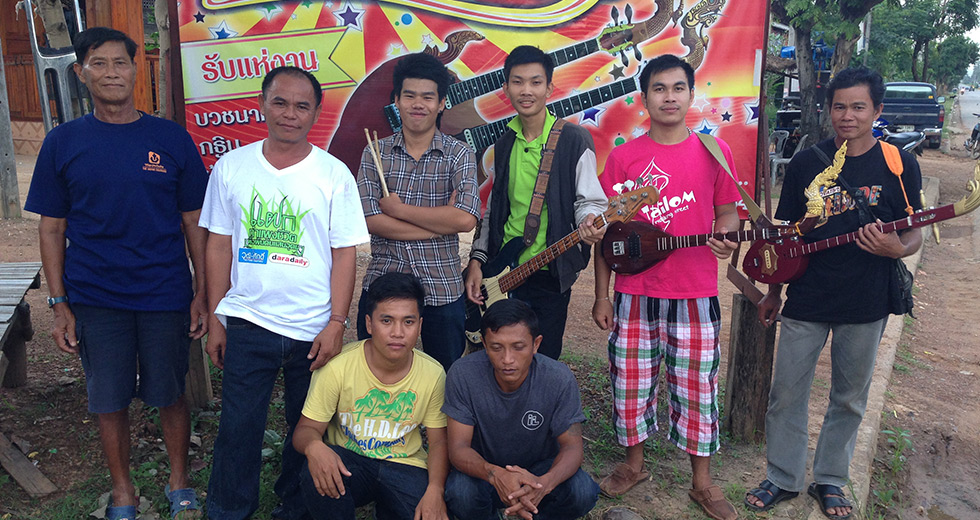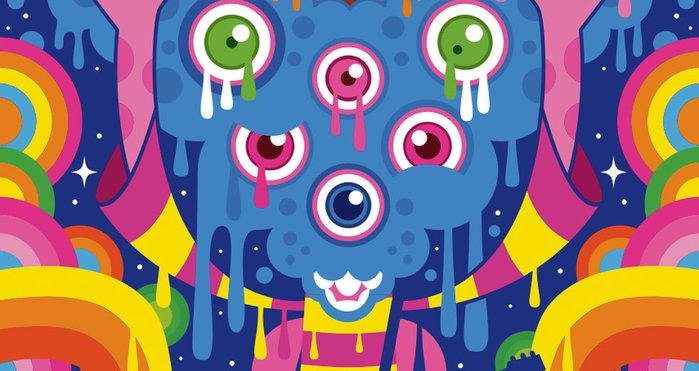Psychedelic Techno Gurus
How counter-culture icons of the first Summer of Love came to be included in the dance music of the second
On a Thursday evening in October of 1995, a crowd of believers at London’s Heaven club erupted into applause as that night’s performance peaked. Never mind that the man they were cheering was Allen Ginsberg and wasn’t even playing any music.
Bald-headed and grey-bearded, Ginsberg fired off lines of verse with ferocious abandon, resurrecting the spirit of the ‘60s for hundreds of adoring clubbers at Megatripolis, London’s most adventurous neo-hippie gathering at the time.
This was the period in the ‘90s when psychedelic gurus became heroes for a certain strain of clubbers, the ones who had surfed the rush of the original acid house and rave scenes and were seeking to put their life-changing experiences into some kind of spiritual or ideological context. A feeling this powerful must have greater significance, they reasoned; it couldn’t just be a technologically updated, chemically enhanced Saturday Night Fever. Or could it?

Thinkers like American ethnobotanist psychonaut Terence McKenna and the high priest of LSD, Timothy Leary, suddenly became influential figures on the more psychedelically inclined fringes of British dance culture. Megatripolis, with its series of Parallel YOUniversity lectures showcasing speakers like McKenna, Ginsberg and Leary associate Ram Dass, was an attempt to focus these energies into some kind of psychedelic rave movement.
Megatripolis also promoted smart drugs, brain machines and a little-known technological development called the internet, which the cognoscenti were hyping as the tool to free mankind from the shackles of information slavery. The club was run by Fraser Clark, the founder of Encyclopedia Psychedelica magazine who believed that the rave scene represented a renaissance of the original hippie philosophy.
Before acid house, “hippie” was the most pejorative word you could use. Now here was the consciousness craze that I had been predicting.
“When I walked into Shoom, my first house club, I saw a hippie thing going on all over again,” Clark told me back in 1995. “Before acid house, ‘hippie’ was the most pejorative word you could use. Now here was the consciousness craze that I had been predicting, and the power of it was that we hadn’t invented it: it wasn’t some old hippie’s plot to try and revive the hippie thing, it had spontaneously combusted among young people themselves.”
Clark preached the idea that rave culture was a contemporary version of the ancient dance-drug rituals of tribal shamans. “The rave scene is the first step to awakening; you dance for hours to shamanic tribal drumming. That clears your head of all your conditioning and your mind is opened. Then you’ve got to re-program it with a different philosophy,” he explained.
It was in this context that veteran psychedelic explorers like Terence McKenna became ideological mentors. In his book Food of the Gods, McKenna set out his theory that from prehistoric times onwards, psychedelic plants had played a vital role in the development of human consciousness. He argued that if such plants were reintegrated into society in contemporary shamanic rituals – raves! – they could avert the ecological crisis facing humanity by facilitating an evolutionary leap to a higher level of consciousness. “With electronic culture you can create shamans for the interplanetary village and this to my mind is the function that rock & roll played in the ‘60s and that house music should play in the ‘90s,” he said.
Among the people listening intently to McKenna were The Shamen, a former psychedelic rock band whose members said they had been transformed with their experiences with acid house. “The acid house and rave scene was very hedonistic back then and in truth, many people didn’t really understand why they were enjoying the culture in the way that they were – they were just doing it. Terence’s ideas definitely fulfilled a role,” explains The Shamen’s vocalist, Mr. C. The band invited the ethnobotanist to give a narration on “Re:Evolution,” a track on their Boss Drum album, which went double platinum after its release in 1992.
It was one of those moments that could perhaps only have happened in the early ‘90s: The Shamen, one of the most popular bands in Britain at the time, decided to release a distinctly uncommercial track – eight-and-a-half minutes of speechifying about the benefits of psychedelics and the “archaic revival” set to a somewhat abstract electronic backdrop – as their next single, knowing that their dedicated fan base would probably launch it into the pop charts.
“We were able to push the views of Terence into the mainstream of society. When we released ‘Re:Evolution,’ we did so right after three huge pop hits,” Mr. C recalls. He’s particularly proud of the fact that because “Re:Evolution” became a hit, BBC Radio One’s popular weekly chart show had to play it in full, giving Britain’s pop kids a herculean dose of propaganda for mind-expanding drugs.
“Nearly all the young people I met in Eastern Europe wanted to try LSD and here was the guru himself, talking about it. As Timothy [Leary] said, ‘My job is to corrupt young people.’”
McKenna wasn’t the only psychedelic sage to hover a techno track in the ‘90s. Timothy Leary was also quick to spot the potential of the rave scene as a marketplace for his ideas; he hung out with the infamous Club Kids at the Limelight in New York and launched his book Chaos and Cyber Culture with a party at Fraser Clark’s short-lived Megatripolis San Francisco franchise back in 1994.
Leary was no stranger to pop culture. He had sung with John Lennon (on the chorus of “Give Peace a Chance”), been involved in making a psychedelic rock album called Turn On, Tune In, Drop Out in 1966 and collaborated with German kosmische band Ash Ra Tempel on an extremely peculiar record called Seven Up in 1972.
However, it was in Berlin where the ‘60s LSD guru joined the techno vanguard in 1990. With the city in a glorious period of chaotic creativity following the fall of the Wall, anything seemed possible. Dimitri Hegemann, the founder of the Tresor club, managed to convince the rector of East Berlin’s prestigious Humboldt University to host a Leary lecture by hyping up him as a professor from Harvard – which he technically had been, until he was fired in 1963. Mark Reeder, the founder of the Berlin trance label MFS, the original home of DJ Paul van Dyk, was in the audience that day. He recalls how Leary delivered his suitably controversial talk with a showman’s verve. “We listened intensely and hung onto his every word,” says Reeder. “He was a bit like a mystic, confirming everything we already believed.”
For me, the early ‘90s were hugely optimistic times, the Berlin Wall had come down, the Cold War ended and the cruelty of the Thatcher years were over… it seemed that the world could really become a better place.
Younger members of the audience were fascinated by Leary’s outspoken advocacy of psychedelic experimentation. “Remember, almost all the kids of East Germany had never experienced hard drugs of any kind, maybe only prescription drugs, or alcohol and cigarettes, nothing up until the fall of the Berlin Wall and so they were very inquisitive, especially when it came to psychedelic drugs,” says Reeder. “All the young people I met in Eastern Europe, nearly all wanted to try LSD and here was the guru himself, talking about it. As Timothy said, ‘My job is to corrupt young people.’”
The lecture was recorded and then used as the lead vocals for a techno album called Psychedelics to Cybernetics, credited to System 01 Featuring Timothy Leary; it also features in Reeder’s fascinating documentary about Berlin counterculture in the ’80s, B-Movie.
Like Leary, novelist and LSD pioneer Ken Kesey also found an enthusiastic new audience among the rave generation. In 1999, he brought his older Merry Pranksters to Britain for a valedictory lecture and film-screening tour, during which his lysergic odyssey across the US in the ‘60s was feted as a glorious antecedent to the outlaw rave scene.
Aging gurus like Leary and McKenna weren’t the only beneficiaries of this ecstasy-inspired search for meaning; the movement also fuelled the nascent psychedelic trance scene, which had arrived in London from Goa around the same time in the early ‘90s. “For me, the early ‘90s were hugely optimistic times, the Berlin Wall had come down, the Cold War ended and the cruelty of the Thatcher years were over… it seemed that the world could really become a better place,” says Phil Ross, one of the promoters of pioneering trance party Return to the Source, which began in London in 1993.
Ross suggests that interest in what became the global psytrance scene was stimulated by the dissident passions of the outlaw rave scene and Fraser Clark’s experiments at Megatripolis, as well as the spiritual wanderers who brought home new influences from Goa.
“You had the perfect storm of ingredients for the trance scene that exploded, along with its Glastonbury shamanic and druidic influences, the hippie hang-over from the ‘60s and the Hindu aesthetic that filtered back via the travellers,” he explains. “People were eager to shake off the ‘greed is good’ ethos of ‘80s Thatcherism and embrace the possibilities of the post-glasnost future.”
Creating such strong personal links between dance culture and the psychedelic ‘60s would be much more difficult today, as many of the main players have long ago left the stage. Timothy Leary died in 1996, Allen Ginsberg in 1997, Terence McKenna in 2000 and Ken Kesey a year later in 2001.
Megatripolis impresario Fraser Clark also passed away in 2009, with his dream of inspiring “shamanarchy” in the UK unfulfilled. Some of his attempts to transform rave culture into a new hippie movement may now appear naïve and easily mocked, but those were different times, and it’s hard to remember now how powerful the combined impact of acid house and ecstasy was when they first blasted into the collective consciousness.
Or as Clark himself put it, back in those remarkable years even the most outlandish schemes suddenly seemed plausible: “What fun it is to be alive today.”

